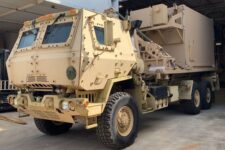By James Jay Carafano
 Left, right. When it comes to the military, those labels aren’t supposed to mean much. But they do because, simply, those who believe in their parties define themselves in opposition to each other. While it rarely provides Americans with the rich debate and soaring rhetoric one sees in a parliamentary system, especially in the House of Commons, pitting the two sides against one another can result in new ideas and better directions. Earlier today, the two sides sat down at an event hailed as High Noon in the nation’s capital and hammered out their positions. The National Review and The Heritage Foundation sponsored the debate, which featured two conservatives and two liberals, Following are the views of the right as delivered by James Jay Carafano of the Heritage Foundation. This was written before the event. To read the Left’s perspective, click here. Let us know who you think presents the answers that best suit the nation’s military. Try to transcend any partisan bent you might have! (We’re trying to get a link to the event debate. If we find one, we’ll post it.) The Editor.
Left, right. When it comes to the military, those labels aren’t supposed to mean much. But they do because, simply, those who believe in their parties define themselves in opposition to each other. While it rarely provides Americans with the rich debate and soaring rhetoric one sees in a parliamentary system, especially in the House of Commons, pitting the two sides against one another can result in new ideas and better directions. Earlier today, the two sides sat down at an event hailed as High Noon in the nation’s capital and hammered out their positions. The National Review and The Heritage Foundation sponsored the debate, which featured two conservatives and two liberals, Following are the views of the right as delivered by James Jay Carafano of the Heritage Foundation. This was written before the event. To read the Left’s perspective, click here. Let us know who you think presents the answers that best suit the nation’s military. Try to transcend any partisan bent you might have! (We’re trying to get a link to the event debate. If we find one, we’ll post it.) The Editor.
“Why bother?” with a debate like this, some may ask. “Debate all you want, it won’t change a thing. . Washington is determined to cash a peace dividend, so defense budgets are going down. Period.”
That’s a rather fatalistic view, but it’s certainly not unreasonable. Many members of Congress view the Pentagon as the place to start chopping when spending cuts are needed—and after a spate of trillion-dollar deficits, spending cuts are definitely needed. The sequester formula in the Budget Control Act of 2011 reflects that view with a vengeance. Defense bears about 50 percent of the cuts required under the BCA, even though the Pentagon’s budget is less than one-fifth of what Washington shells out.
Further, cheerleading for declining defense spending has become something of a bipartisan sport. Voices on both sides of the aisle seem content with the notion that America can do quite well with a smaller military.
Call it Washington insouciance, or call it indifference toward defense, but that attitude has been on display in recent weeks, in Capitol Hill’s non-response to warnings of deteriorating readiness from the armed services. The Air Force announced it has grounded more than a dozen air wings world-wide. Washington yawned. Both the Navy and Marines reported readiness levels plummeting. Ho hum.
It’s not like military preparedness is a national priority or anything. Certainly nothing as troubling as the prospect of air traffic controller furloughs creating longer wait times at the airport. Washington sprung to action on that one.
The difference in responses is pretty easy to explain. Lawmakers feared blowback from inconvenienced air travelers. (And they fly quite a bit themselves, too.) Yet few in Washington worry they’ll lose votes for going along with the Obama administration’s plan for cashing in the peace dividend.
Yet, for all of that, a debate on defense funding is still a showdown worth having.
The reality is that defense’s contribution to deficit reduction is going to be short-lived. Like a sharp heroin fix, it may make Washington feel fine for a while. But even if D.C. drained the Pentagon accounts dry, the cravings for more and more cash would remain.
And, there are real-world consequences to raiding the Pentagon piggy-bank. Readiness and capabilities are already reduced. And just as soon as the White House needs to call out those forces (Syria? Iran? North Korea? Who knows?), the cries to cut spending will be quickly muted when it becomes apparent that not all the forces needed are operationally ready.
We’ve seen this play out before. Washington is simply reprising the feel-good approach of Clinton-era budgeting. Clinton used to defense budgets to help drive towards a balanced budget, but the shortfalls exposed by operations in Bosnia and Kosovo, coupled with an upcoming national election, convinced the administration to stop digging through the cellar of defense readiness.
Sooner or later, international realities will force Washington to whipsaw back the other way on the Pentagon’s bottom line. The real issue is: How great a risk is Washington willing to let Americans—especially those serving in the armed forces—live with in the meantime.
And, that is something worth debating.
No one in Washington can argue with a straight face that the White House is cranking out defense strategies that are anything other than budget-driven. One side may argue—so what? The Pentagon is too big anyway—or has the wrong military for the next mission—or can do more with less if the armed forces were just more efficient.
The other side might argue that the U.S. cannot afford to ignore serious threats, and that the imperative to cut spending should not trump the imperative to deter danger and be ready to prevail should combat become unavoidable.
These are arguments worth listening too. Rather than bog down in the details of sequester or troop levels — a serious strategic debate about the costs and benefits of cashing a peace dividend is very much in order.
No service can fight on its own: JADC2 demands move from self-sufficiency to interdependency
Making all-domain operations a warfighting capability means integrating, fusing, and disseminating a sensor picture appropriate for a particular theater segment, not all of them, says the Mitchell Institute’s David Deptula.



























